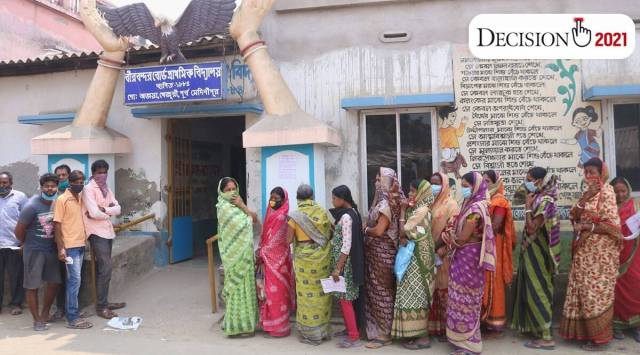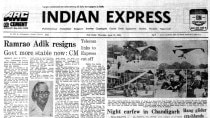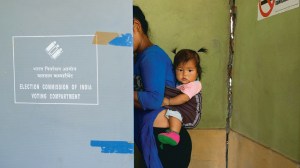- India
- International
The outsider vs insider debate in Indian politics
In West Bengal, the Trinamool Congress has projected its leader Mamata Banerjee as the daughter of Bengal. Prime Minister Narendra Modi, on the contrary, is overriding such localism and emphasising the equality of all Indians, thereby projecting a pan-Indian nationalism.
 In today’s mass democracies, in the absence of a philosophy of a common good or a general will, as observed by Schumpeter, a proper mechanism of representation based on politics of presence is essential. The demand of 33 percent quota for women in the Indian parliament and legislative assemblies emanates from this desire for visibility. (File photo)
In today’s mass democracies, in the absence of a philosophy of a common good or a general will, as observed by Schumpeter, a proper mechanism of representation based on politics of presence is essential. The demand of 33 percent quota for women in the Indian parliament and legislative assemblies emanates from this desire for visibility. (File photo)(Written by Subrata Mukherjee)
In the ongoing Vidhan Sabha elections in four states and one Union Territory, there is a debate about an insider and an outsider to a state. In West Bengal, the Trinamool Congress has projected its leader Mamata Banerjee as the daughter of Bengal. Prime Minister Narendra Modi, on the contrary, is overriding such localism and emphasising the equality of all Indians, thereby projecting a pan-Indian nationalism. This larger framework of constitutional citizenship is inadequate in explaining the contradictions and inherent localism and dualism of our nationhood which was noted even by Rabindranath Tagore.
With the establishment of the three universities in Bombay, Madras and Calcutta in 1858, a new chapter in these contradictions got manifested. The University of Calcutta with its twin advantages — first, being in Calcutta which was also the capital of British India and second, its jurisdiction extending up to Visakhapatnam, Kabul and Rangoon — enabled its graduates to secure a disproportionate share of governmental jobs throughout India.
As a result, the Bengali bhadraloks spread all over India because of their fluency in English. But this created serious tension between them and the local elite leading to considerable anti-Bengali feeling, which at times became violent, in Orissa, Assam and Bihar.
In Assam, where migration was a significant feature in the state’s demography, a piquant situation was created with the emergence of two cultures, the Assamese-dominated Brahmaputra valley and the Bengali-dominated Barak valley. The Bongal Kheda movement became acute and has become a dominant facet of electoral politics in independent India. In Mumbai and Maharashtra politics, the rise of the Shiv Sena was a direct attack on outsiders — first on the Tamilians and then on Malayalis and others.

The tussle for Belgaum between Karnataka and Maharashtra is well known. The subcultural hostility to outsiders assumed a different form in Tamil Nadu with the self-respect movement. Periyar contemplated separation and propagated a separate Dravidastan which was only modified by Annadurai, after the Indo-China War of 1962.
Historically, the failure of the Indian Association led by a liberal Surendranath Bannerjee in 1876 was mainly because it was unable to earn confidence nationally. The reason for this was over centralisation with its central office in Calcutta. The founders of the Indian National Congress (1885) were well aware of this contradiction as well as the suspicion that each regional group harboured against the others.
Hence, they deliberately chose to keep it a loose organisation with no central office, no constitution and with the stipulation that no divisive issue in the name of region, caste, language and religion would be entertained. But, in spite of such caution, the Aligarh Movement led by Sir Syed Ahmad Khan, distanced itself from the Congress. His suspicion of the Congress was because of the existence of a permanent majority and a permanent minority. This was perceived to be a structural flaw. With the beginning of electoral politics, representation became a crucial issue. The Muslim elite realised that the electoral battle was unequal. It could not envisage a power sharing arrangement.
Nationalist Muslims like Badruddin Tyabji as early as 1887, as the first Muslim president in his presidential address to the Congress, reminded that safeguards for minorities were absolutely necessary. Sir Syed’s outburst against the upper caste Hindu bhadraloks emanated mainly because of their disproportionate share of the privileged and scarce elite government jobs. He was disturbed by the fact that few Muslims qualified in the ICS examinations.
Representation in politics and other crucial areas has always been contentious. The old Burkean principle of virtual representation is grossly inadequate in the modern representative form of governments as it pertained to interests which had to be “objective, interpersonal and unattached”.
Burke was of the view that aristocracy of virtue and wisdom ought to govern for the good of the nation and regarded members of parliament to be an elite group, a natural aristocracy. Since they had the capacity for rational decision making and were men of practical wisdom, they were superior to ordinary people. They needn’t be bound by the views of the electorate. Burke’s views endorsed the 17th century notion of representation and have little relevance to contemporary times. Moreover, his views were highly inconsistent.
In today’s mass democracies, in the absence of a philosophy of a common good or a general will, as observed by Schumpeter, a proper mechanism of representation based on politics of presence is essential. The demand of 33 percent quota for women in the Indian parliament and legislative assemblies emanates from this desire for visibility.
The 50 percent reservation of women in the panchayats, the SC/ST reservations in elected offices, and in the civil and other services, flow from their desire to enhance their social mobility. Moreover, they see themselves as disadvantaged groups who have suffered in the past and as needing social justice.
Another serious problem of representation is the north-south divide in India. The constituencies in the south have become smaller in comparison to the north due to success in family planning. This is one of the reasons for the deferment of delimiting constituencies. Both in the legislative assemblies and Lok Sabha, elected representatives from the southern states, as compared to the northern states, would represent far fewer people. But, if the electoral constituencies are redrawn, the south would suffer while northern states like UP and Bihar would gain.
In pre-Partition Bengal, there was an interesting debate regarding the relationship of a Muslim-majority province within a larger Hindu nation. A distinctive regional Bengali identity based on language emerged. After Partition, it took a different but much more powerful form, ultimately leading to the emergence of Bangladesh in 1971 after East Pakistan split with West Pakistan. Within West Bengal, it developed in a different manner with total opposition to the talks of merger between Bengal and Bihar.
Such a merger was promoted by the State Reorganisation Commission in 1955. The state so formed would be named Purva Pradesh but that was abandoned after widespread protests in 1956. In all these developments, the multiple basis of Indian nationalism emerged, reflecting different layers of accommodation and conflict. For instance, large sections of Assamese Hindus seem to have antipathy towards Muslim and Hindu Bengalis and are suspicious of any further increase in Hindu migration from neigbouring states or from Bangladesh.
Gandhi was well aware of these basic contradictions — of India comprising myriad identities. While rejecting the British map, he made his own linguistic map with an organisation representing all categories of people to make it a composite whole.
This greater unity in diversity is reflected in the electoral politics of representation where politics becomes a great balancing act between particular interests (like Rajbanshis and Matuas in West Bengal) and also an intricate balancing between outsiders and insiders. Unfortunately, in this increasing fragmentation, a VK Krishna Menon winning from Midnapore or a SM Banerjee winning from Kanpur to Lok Sabha look increasingly improbable though celebrities like Prime Minister Narendra Modi from Varanasi and Rahul Gandhi from Wayanad in Kerala do win with comfortable margins.
(The writer retired as professor of political science in Delhi University.)
EXPRESS OPINION
More Explained
Apr 19: Latest News
- 01
- 02
- 03
- 04
- 05









































